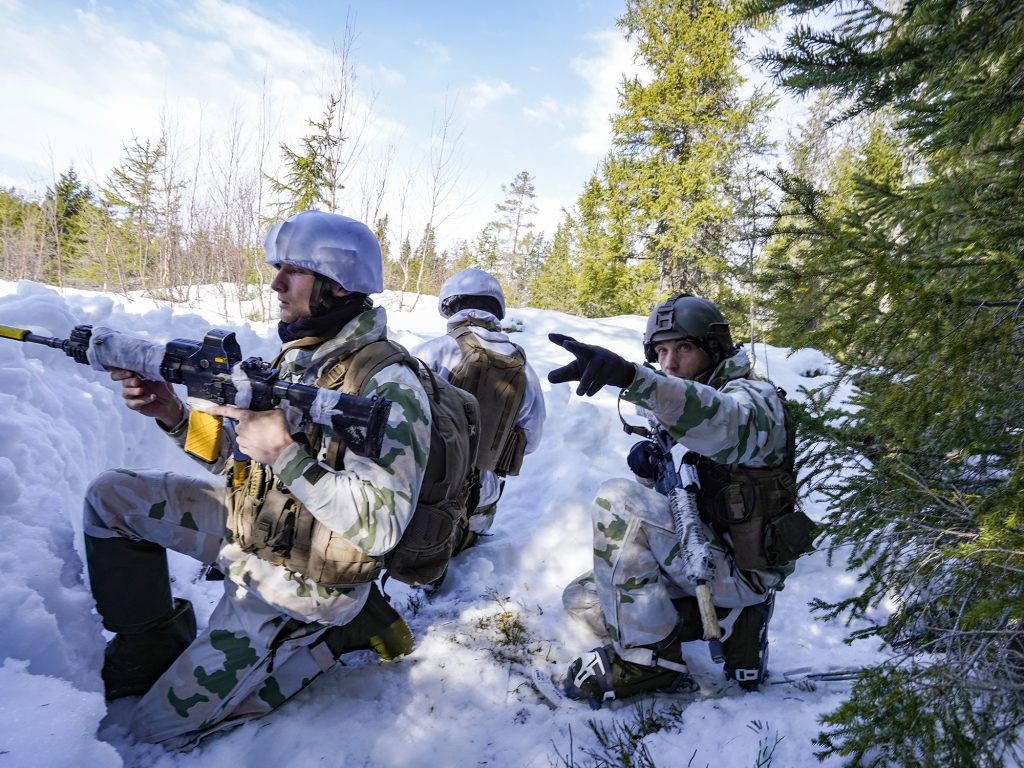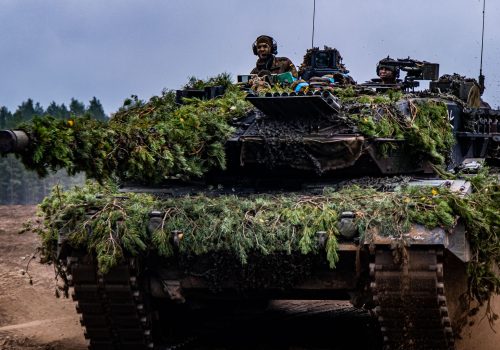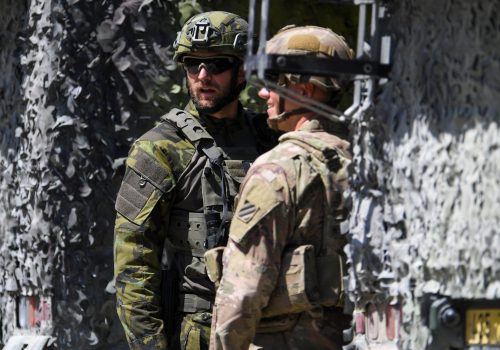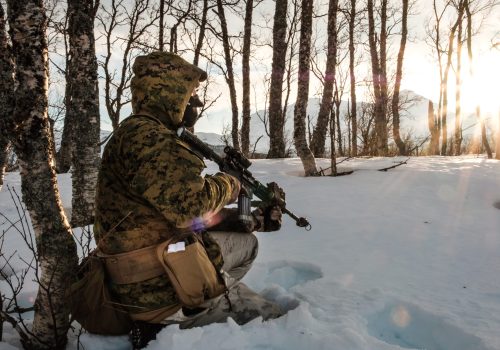As the Arctic continues to be fundamentally reshaped, the United States and its allies in the region will need to quickly adapt by strengthening their collective security and expanding their Arctic awareness. Arctic-ready unmanned aircraft systems (UAS) can help them adjust to the changing landscape.
The transformation of the Arctic—one of the world’s harshest environments—is being fueled by two significant factors: climate change and Russia’s full-scale invasion of Ukraine. First, climate change is heating the Arctic, causing ice to rapidly recede: Some estimates say that the Arctic could be ice-free (during the summer) as soon as 2035. That is making natural resources and shipping lanes more accessible. The Arctic holds nearly 30 percent of the world’s undiscovered natural gas; it also hosts growing fisheries that commercial (as well as illegal) operations will aim to exploit. Additionally, the Arctic region has the potential to connect roughly 75 percent of the world’s population, making quicker Arctic routes extremely valuable for commercial and illicit traffic.
Second, Russia’s invasion of Ukraine (taking place over 1,700 kilometers from the Arctic Circle) has largely ended cooperation between Moscow and the countries known as the Arctic 7—Canada, Iceland, Denmark, Norway, Sweden, Finland, and the United States—as Russia further militarizes and disputes Arctic territory and resource ownership.
Together, these two factors are contributing to increases in commercial traffic, illegal shipping and fishing operations, competition over natural resources, and militarization.
Russia controls 53 percent of the Arctic Ocean coastline and has made massive investments in building and modernizing its Arctic bases, fleets, and weapons systems over the past two decades. During this time, Russia has been building up a fleet of nuclear-capable icebreakers, ships, and submarines; established more mining and drilling operations; and made moves that suggest it aims to control Arctic Sea routes normally accessible to all. Russia has also militarized its fishing vessels, icebreakers, and other commercial vessels and has taken increasingly aggressive actions in the Arctic as it disputes jurisdiction over territorial waters and seabeds.
When it comes to investing in Arctic security, the Arctic 7 countries—all of which are NATO allies except for pending member Sweden—are largely playing catch-up in their efforts to counter Russia’s investments. However, over the past year, US and NATO leaders have woken up to the evolving environment and have reinvigorated their focus on Arctic security. If the United States and its Arctic allies hope to quickly improve security in this vast region, they will need to expand Arctic awareness in a way that is efficient, is cost effective, and reduces risk to personnel and critical assets.
New modernized Arctic bases and fleets could expand Arctic awareness, but they’re a tall order, even in the long term. The Arctic is a very harsh environment for ground forces, and expensive naval vessels and manned aircraft cannot safely and efficiently cover the region without backup. For example, manned aircraft traditionally need a secondary rescue capacity in case they go down. This requires costly resources in terms of additional training, personnel, basing, and aircraft.
However, cost-effective, Arctic-ready unmanned aircraft systems (UAS) may help the allies fill their security gaps today. If a UAS goes down, there is no need for a rapid rescue mission because the remote pilot and crew are safely on the ground in another location. As a cost-effective complement to manned assets, UAS also can remotely fly longer missions using satellite communications, connect joint forces, and maintain a shared real-time intelligence picture of the Arctic, reducing the overall cost of expanded operations and eliminating risks to human pilots or crew. Leveraging UAS would enable Arctic allies to quickly expand coverage in the region from anywhere in the world. (Disclosure: I work for General Atomics Aeronautical Systems, which manufactures one of several such UAS models.)
Monitoring increased commercial and illegal activity
With climate change’s dramatic effects on the Arctic, and the resulting increased maritime traffic and geopolitical competition for commercial control, NATO will need continuous airborne situational awareness and communications within the Alliance and with Arctic partners. New Arctic-ready UAS are ideal assets for conducting such civil operations in the Arctic. With the ability to withstand extremely low temperatures and the ability to fly long missions via satellite, Arctic-ready UAS are well suited for continuously monitoring shipping lanes, fisheries, and environmental disasters, and for conducting search and rescue operations. More UAS over the Arctic could enhance cooperation, help ensure the safety of peaceful commercial activity, and improve climate security.
For example, if a ship is in distress and a UAS is on mission, the aircraft can easily be tasked to provide video, radar, and communications relay in support of first responders; the UAS could potentially deploy life-saving emergency supplies directly. Similarly, if there are reports of illicit fishing operations and a suspected vessel turns off its transponder identification, UAS can help authorities to locate, identify, and apprehend the vessel, removing the guesswork and initial risks to human patrols.
Arctic-ready UAS can also be valuable research tools for monitoring wildlife, icemelt, and more to help scientists understand the environmental and community impacts of climate change, despite complications brought on by Russia’s invasion of Ukraine. Before, Russia and the Arctic 7 were largely able to collaborate on important environmental research and socio-economic development activities in the region through the Arctic Council. But due to Russia’s invasion, the Arctic 7 countries have largely isolated Moscow from ongoing activities at a cost of resources and regional access. The use of UAS could help fill gaps by supporting important airborne research on the impacts of climate change on Arctic ecosystems and communities.
Addressing Russian militarization
The United States and NATO need to focus on quickly expanding collective surveillance capabilities to help deter aggression, avoid unnecessary escalation, and strengthen cooperation between Arctic allies and partners. Many available UAS, which are familiar among the US Air Force and NATO allies who widely operate them already, could help quickly and cost-effectively monitor and address Russian activity in the Arctic.
A fleet of Arctic-ready UAS would significantly multiply the intelligence, surveillance, and reconnaissance capabilities of joint forces and serve as a credible deterrent at lower costs—and without risking lives. And because many UAS are generally flexible, commanders can tailor them for a growing list of missions with unique intelligence payloads, including submarine detection capabilities. Some UAS can dispense and monitor sonobuoys to detect and track Russian submarines to help protect vulnerable maritime assets. Some new UAS can also detect various signals at long ranges, making them a formidable early warning system for incoming Russian aircraft, vessels, or even missile systems.
These capabilities would enhance the United States’ and NATO’s understanding of Russia’s actions and intentions in the region, reducing the risk of unnecessary escalations. In addition, with UAS on patrol, NATO allies could let any malign actors know that they are being watched to deter aggression in disputed or contested areas. This is often referred to as “deterrence by detection.”
With Arctic security challenges on the rise, the United States and NATO need to rapidly strengthen their collective security in the tundra. In the short term, Arctic-ready UAS could bolster joint forces’ and civil authorities’ abilities to collect and deliver actionable information over satellite to the Arctic 7 and the wider allied intelligence community, while removing risk to human pilots and decreasing the overall cost of expanded and sustained security operations. A more complete shared intelligence picture will strengthen awareness and cooperation in the Arctic as allies adapt to and address evolving security challenges.
If Arctic allies spend too much time searching for other solutions to get ahead of evolving security challenges, only to ultimately land on riskier options, they may allow security gaps to grow. Governments and military leadership must move quickly to ensure a more peaceful and secure Arctic.
Kirk Allen is a millennium fellow at the Atlantic Council and a digital communications lead at General Atomics Aeronautical Systems, Inc.
Further reading
Tue, Apr 18, 2023
NATO deterrence and defense: Military priorities for the Vilnius Summit
Issue Brief By Franklin D. Kramer
Ahead of the NATO Summit in Vilnius, this issue brief sets forth six priority actions that NATO should undertake to enhance its deterrent and defense posture.
Fri, Jul 22, 2022
Now for the hard part: A guide to implementing NATO’s new Strategic Concept
New Atlanticist By Hans Binnendijk, Timo S. Koster
NATO should be proud of its recent accomplishments—but now it needs to follow through.
Wed, Mar 30, 2022
All security is local: Arctic defense policies and domain awareness
Report By
This report maps Arctic allies' and partners' defense strategies and domain awareness capabilities to make recommendations for enhancing Arctic security.
Image: In the middle of a snow-covered pine forest, a group leader of the 13th Alpine Hunter Battalion gives orders to his subordinates in their snow-covered fighting hole. Exercise Cold Response 2022. Photo by Frederic Petry/Hans Lucas via Reuters.



